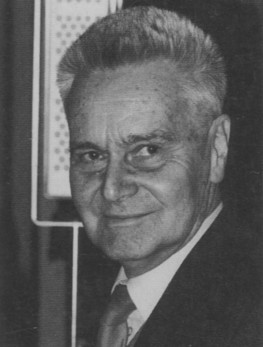
Figure 1: Jan Tinbergen
In the book Economic policy: principles and design1 the well-known Dutch economist Jan Tinbergen describes an interesting micro-economic model of the labour market. The model excels thanks to two hallmarks. First, both the properties of the unemployed and those of the offered positions are modelled in detail by means of the method of Quetelet. And second, the preference of the unemployed is expressed in a cardinal utility function. The model allows to calculate the distribution of the labour incomes. Tinbergen shows that the results can be used for policy recommendations.
In the model of the labour market two theoretical approaches are combined, which have already been applied in the previous columns. First, in the column about the marginal utility of money it has already been explained that the social-democrat Jacob van der Wijk applies the method of Quetelet. According to Quetelet there exists an "average person". Therefore the formulas of probability theory and of statistical theory can be used for the description of individual properties and behaviour. Second, in the column about the scaling of the monetary utility it has been explained that the economist Bernard van Praag expresses the individual utility in a mathematical function. Both concepts, the probability distribution and the utility function, are integrated in the present model.
The model illustrates the practical manner of Tinbergen in studying economic phenomena. Besides, it is clarifying to see that the discussed concepts (human properties, human utility function) can be integrated and combined within a single model. And the functional relations of the model offer points of application for the welfare policy of the state, so that they help to avoid unintended side-effects. Incidentally the model is kept simple, and just an illustration of approach.
First, the labour market will be modelled. Suppose that there of I properties of unemployed, which are relevant for the transactions on the labour market. Assume that to each property i an indicator ti can be attached. Let there be a measuring scale, so that a numerical value can be given to the indicator ti for each unemployed. It is obvious that the intensity or productivity of working is an important property. Give this property the index i=1. Furthermore in the column about the scaling of the monetary utility it turned out, that the size of the household of the unemployed is essential for the individual utility. Give this family property the index i=0. Thus there are in total I+1 properties, numbered i = 0, ..., I.

Apparently the properties of the unemployed can be represented by a vector t in a space with I+1 dimensions. People are different to such an extent, that the I+1 indicators are insufficient for uniquely determining each unemployed. Therefore a number of unemployed belongs to each vector t. When that number is divided by the total number of unemployed, then one finds the fraction n(t) of unemployed, whose properties equal the vector t. In other words, the function n(t) is the multi-dimensional frequency distribution of the properties of the unemployed. She is also called the (probability) density function.
In this model the measuring scale registers continuous values for the indicators ti. Therefore it is convenient to interpret n(t) as a continuous function in its I+1 dimensions. It is obvious that thus the individual unemployed becomes invisible, and is replaced by the chance, that an arbitrary unemployed disposes of certain properties. The fraction of unemployed with indicator values in the differential interval [ti; ti + dti] (with i = 0, ..., I) is given by n(t) × dt, where dt represents the infinitesimal volume.
In a completely analogous manner the properties of the offered positions can be modelled. Enterprises with a vacancy redact a profile for that position, that is based on the just defined properties. For each vacant position the indicator si can obtain a certain value. However, since the size of the family is irrelevant for the performance at work, here the property i=0 is left out. Then the vector s has I dimensions. Let the density function of s in the space of free positions be m(s).
Since now t represents a vector of stochastic variables, its average ν and its variance τi² can be computed for the professional population as a whole. Here τi is the standard deviation of the property i. In the same way s is characterized by its average μ for the vacancies together and by its standard deviation σi. The demand and the supply on the labour market are brought in equilibrium by the labour wage w(s). The equilibrated market is completely cleared, as soon as each unemployed with properties t is hired in a vacant position with properties s. That is to say, a unique transformation from t to s exists. She can be represented by the function t = Ψ(s), or her components ti = Ψi(s).
Now define the matrix F by Fij = ∂Ψi / ∂sj. In the differential calculus F is called the functional matrix of Ψ. The determinant of F is called the Jacobian JF of the transformation Ψ, or the functional determinant. Next, note that the element ds in the space of the vectors s of free positions spans a volume ds1 × ds2 × ... × dsI. In the same manner the element dt in the space of the vectors t of unemployed spans a volume dt0 × dt1 × ... × dsI. It is known from the differential calculus, that the ratio of the volumes ds and dt just equals the value of the Jacobian2. In formula that is dt = JF × ds.
The mentioned market equilibrium and the thus guaranteed market clearing can be represented by the equality ∫ n(t) dt = ∫ m(s) ds. When here dt = JF × ds is inserted, then the result is
(1) m(s) = JF × n(t)
Thus the labour market is modelled in its general form. Next Tinbergen simplifies the model by means of several assumptions. First, he assumes that the properties ti of the unemployed are mutually independent. Then the density function becomes n(t) = n0(t0) × n1(t1) × ... × nI(tI). In the same way the properties of the vacancies are mutually independent, so that one has m(s) = m1(s1) × n2(s2) × ... × nI(sI).
Besides, Tinbergen assumes for the density functions ni(ti) and mi(si) (with i = 1, ..., I), that they are normal distributions. In other words, the properties behave like a Gauss curve, also caled the line of Quetelet, because he was the first to apply her in sociology. Here the reader sees that Tinbergen follows the example of Van der Wijk. However, Van der Wijk considers merely one property, namely the psychic income. To be concrete, now one has
(2) ni(ti) = exp(-(ti − νi)² / (2 × τi²)) / (τi × √(2×π))
A similar formula can be found for mi(si), albeit with μi and σi. Apparently in the model the properties ti of the unemployed have a symmetrical distribution around their average value νi. And in the same way the properties si of the vacant positions have a symmetrical distribution around their average value μi. The spread is purely arbitrary, without skewness. This completes the model of the labour market.
Tinbergen develops an empirical function for the utility of a certain vacant position for a certain unemployed. The vacancy is characterized by the properties s, and the unemployed by the properties t. Tinbergen uses a similar argument for utility effects as the economist B.M.S. van Praag in the previous column about the utility of money. There the utility is determined by the logarithm of the economic variables. The utility function of Tinbergen is3
(3) u(t, s) = ln((1 − γ) × w(s) / (t0/ν0)) − φ(t1) − Σi=2I λi × (ti − si)²
The variable γ is the tax rate, so that (1 − γ) × w(s) is the available income. The loyal reader of the previous columns recognizes in the term (1 − γ) × w(s) / t0 the individual income in the household. The term ν0 is added for the sake of convenience, but it does not change the utility distribution. According as the labour intensity t1 increases, the displeasure will usually rise. The exact functional relation of this displeasure is not specified, but represented by the function φ. She will commonly rise with t1, and Tinbergen even believes that its slope will increase, just like Sam de Wolff did. Indeed one can not escape from the impression, that here De Wolff is the tutor4.

The final term expresses, that differences between the personal properties and the requirements of the position lead to feelings of displeasure5. Considering the assumption of an average spread in the individual properties, both the positive and negative deviations will lead to displeasure. This is taken into account simply be squaring the deviation. It is striking, that Tinbergen has a pragmatic attitude towards the concept of utility, and that he does not avoid the cardinal approach. It is likely that this has been an inspiration for the work of Van Praag. Moreover, the formula 3 implies the hedonistic wage theory, although apparently she dates from 1974, so after the publication of Economic policy: principles and design. For, the unemployed is willing to give in some wage in return for a more fitting position.
The wage term w(s) deserves some discussion. In the preceding paragraph it has been remarked, that at least in this model the labour wage originates from the equilibrium on the labour market. It has already been stated, that in the equilibrium the vacancy s is filled by a worker with properties t = Ψ(s). It is obvious that the income must also depend on the quantity p(s, t), that this worker can produce in his job. Tinbergen uses a production function for the worker of the form
(4) p(s, t) = α0 + α1 × t1 + Σi=2I αi × ti + Σi=2I βi × si
The term α0 is the productive base, which depends on the average job requirements μ and on its spread σi (i = 1, ..., I) 6. The two terms in the middle in the right-hand side of the formula 4 depend on the quality of the worker. Only the final term relates the production function to the specific properties si of the job, although each job-requirement naturally also contributes a little to μ and thus to the determination of α0.
On the labour market the interaction between the unemployed and the enterprises creates the market equilibrium7. The enterprises will offer free positions, as long as this allows them to make a profit. Their total offer determines the productive base, which will be available. But for the rest Tinbergen does not discuss the influence, which the maximization of the profit will exert on the variables si and on the parameters μ and σi of their density function.
The model does analyze the decision-making of the unemployed. First, the unemployed must choose for such a labour intensity t1, that his utility will be maximal. In formula this is ∂u/∂t1=0, where u is given by the formula 3. The application of the chain rule ∂u / ∂t1 = [∂u / ∂(ln(w))] × [∂(ln(w)) / ∂p] × [∂p / ∂t1] and of the formula 4 leads to the result
(5) α1 × ∂(ln(w)) / ∂p = ∂φ / ∂t1
In the preceding paragraph it has already been stated, that φ(t1) will commonly rise. In the simplest case the rise is linear. Therefore Tinbergen assumes that one has ∂φ / ∂t1 = α1 × L1, where L1 is a constant. The consequence is, that ln(w) must contain a term L1 × p. Note, that this model fits poorly with the system of the piece wage, where w is proportional to p. On the contrary, here the wage rises in an exponential manner with the production8.
Next, the unemployed will prefer the vacancy with properties s, which maximize his utility. In formula this is ∂u/∂si = 0 for i=2, ..., I. The chain rule is again useful: ∂u/∂si = [∂u / ∂(ln(w))] × [∂(ln(w)) / ∂si]. Together with the formula 4 one has
(6) ∂(ln(w)) / ∂si = 2 × λi × (si − ti)
Unfortunately these devations si − ti on the labour market do not allow to simply derive the dependency of ln(w) on si. Tinbergen decides to choose a very simple form for ln(w), namely
(7) ln(w) = ρ × ln(ν0 / t0) + L0 + L1 × p + Σi=2I Li × si
The p-dependency follows from the formula 5. The constant L0 defines a kind of statistical minimum wage. The term ln(ν0 / t0) has a different meaning in the formula 7 than in the formula 3. Here he implies that the state tries to influence the size of the population. Households with a size above ν0 receive a family allowance. On the other hand the incomes of the households with t0 < ν0 are taxed, perhaps in order to finance the compensation scheme for large families9.

According to the formula 7 a decrease of one of the properties si (i>1) leads apparently to an exponential rise of the wage. Note, that the si have a normal distribution, so that the chance of extreme outliers is small. Next the formula 4 can be inserted in the formula 7, and then the formula 7 can be inserted in the formula 6. The result is, after a simple rearrangement of terms,
(8) ti = si − (L1 × βi + Li) / (2 × λi)
When the constants are all positive, which is likely, then apparently in the market equilibrium the properties of the unemployed are structurally lower than the job requirements. Besides there is a one-to-one relation between the individual properties ti and the requirements si. Therefore the Jacobian in the formula 1 equals JF=1. Apparently the transformation t = Ψ(s) leaves the volumes unaffected. When moreover the density functions are simplified in the way, that is proposed immediately after the formula 1, then one has
(9) mi(si) = ni(si − (L1 × βi + Li) / (2 × λi))
Apparently the distribution of the properties of the unemployed prescribes the kind of jobs, which must be offered. When ni(ti) has a normal distribution according to the formula 2, and mi(si) as well, then there even exists a direct relation between the mutual averages and variance. She is
(10) (si − μi)² / σi² = (si − νi − (L1 × βi + Li) / (2 × λi))² / τi² − 2 × ln(σi / τi)
The formulas 8 until 10 crown it all in this model of the labour market. It is apparently in the interest of the unemployed, that the economic structure takes into account their skills and experiences. A good regulation of the economy contributes to the social well-being. There exists a thing like "decent work", although it must be admitted, that this conclusion follows naturally from the choice of the formula 3.
The situation becomes still more clear, when it is supposed that the entrepreneurs take into account in their demand for workers the offered skills. The formula 10 simplifies significantly by assuming, that the entrepreneurs create job by using the rule of thumb σi = τi. For, then one must have
(11) μi = νi + (L1 × βi + Li) / (2 × λi)
That is to say, the average requirement i of all jobs together satisfies the same formula 8 as the separate requirement i of each job. Both the utility constant λi and the wage constants Li exert influence on the relation. The entrepreneurs have some latitude in the creation of jobs by making a wise choice for the wage structure of the formula 7. On p.242 of Economic policy: principles and design Tinbergen points out, that the state can also exert some influence. This is immediately clear for the tax rate γ. Moreover, the state can change the properties ti by means of its educational policy. And finally, the state can intervene in the function w(s) by means of a macro-economic wage policy. These points are further addressed in the next paragraph.
On p.194 and further in Economic policy: principles and design Tinbergen shows that a simple model of the labour market allows the state to develop a policy of well-being. In particular, the state can shape the income distribution. First, the formula 4 directly allows to calculate the national production per worker:
(12) pland = α0 + α1 × ν1 + Σi=2I αi × νi + Σi=2I βi × μi
It is obvious that the general welfare will increase, according as the average production pland per worker increases. This can be accomplished by increasing ν1, for instance by encouraging that workers become more disciplined. The formula 3 shows, that such a policy is two-edged. On the one hand, the satisfaction increases thanks to the rising w, but on the other hand dissatisfaction is created due to the function φ(t1). This is precisely the argument of Sam de Wolff in his labour theory of value. A better policy instrument consists of raising νi (i = 2, ..., I) by means of education and training. According to the formula 2 this increasespland without undesirable side-effects.

Usually people feel more happy in an egalitarian society. Therefore the state can further the well-being by reducing the spread in incomes. The model actually contains formulas, that allow to calculate the national inequality of the incomes. For this insert the formula 4 in the formula 7, and eliminate the term L1 × β1 + Li with the help of the formula 11. The result is
(13) ln(w) = ρ × ln(ν0 / t0) + L0 + L1 × (α0 + α1 × t1 + Σi=2I αi × ti) + 2 × Σi=2I (μi − νi) × λi × si
Tinbergen assumes, that ln(t0) has a normal distribution, where τ0² is the variance10. It has already been assumed, that the other ti and si have a normal distribution. It is known from the statistical theory, that functions with the properties of ln(w) have a normal distribution themselves. To be precise, ln(w) must have a variance equal to11
(14) σln(w)² = ρ² × τ0² + L1² × α1² × τ1² + L1² × Σi=2I αi² × τi² + 4 × Σi=2I (μi − νi)² × λi² × σi²
The formula 14 contains clues for the reduction of the spread in incomes, and therefore is fascinating. Consider the first term with the variable ρ, which models the family allowance. Its seems as though the leveling requires ρ=0, but that is incorrect. Namely, when the formula 13 is inserted in the formula 3, then in the individual utility function u a family term (ρ − 1) × ln(ν0 / t0) appears. Apparently the family allowance with ρ=1 can make the utility u independent of the family planning. In other words, in the last resort one must not consider the labour income per household, but the labour income per family member.
It is obvious, that the model does not take into account all aspects, which in the real world affect the labour market. Any model is by definition incomplete. However, the mathematical presentation makes the problem more transparent and she clarifies the dependencies between the various variables. The model gives more economical insight than for instance the list of keywords of Hendrik de Man, which incidentally is also incomplete. Thus the model is truly helpful for the avoidance or discovery of errors of thought.